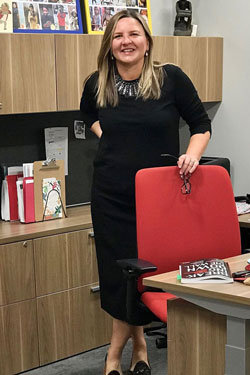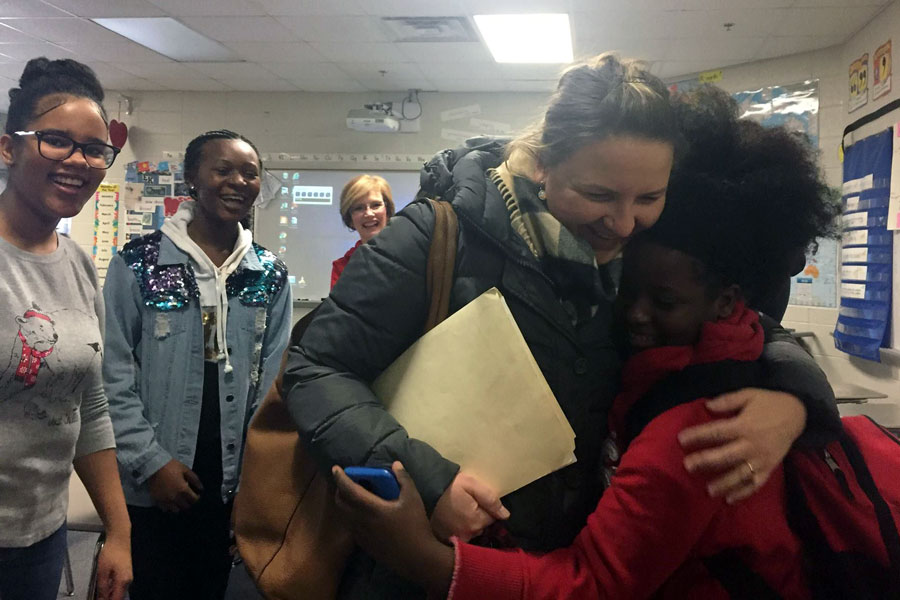Kentwood — English-language learner supervisor Sanela Sprecic has come a long way from when she first arrived in Kentwood as a refugee from Bosnia.
After arriving in Michigan with her husband and young daughter in 1997, she found the city — and school district — to be a welcoming place. The family joined a population of refugees who had resettled after they fled the country during and shortly after the Bosnian War, which extended from 1992 to 1995.
At that time, many immigrant groups were beginning to settle in the area. Sprecic found it to her liking despite the difficult adjustments refugees often face.
“When you are a refugee… you’re forced to flee your country and when you come to an area, oftentimes your status is not equal to others, or people look down on you or are afraid of you,” she said.

“(But when) I think about Kentwood, Kentwood is an attraction to all these people from different countries. You don’t feel alienated. In our school you look at refugees and other kids as having the same opportunities. You aren’t being judged.”
Sprecic began working as an English-language learner paraprofessional in the district. Since then — with the support of Kentwood educators — she has earned a bachelor’s degree, a master’s in educational leadership and is working on a Ph.D. She is now the district’s EL supervisor overseeing 50 EL staff members districtwide. Seventy general education teachers are also EL certified.
She is an example of how Kentwood administrators work to hire staff who reflect the student body in the most diverse district in the state. In 2019-2020, according to MiSchoolData.org, 33% of students in Kentwood were African American, 29.49% were white, 15% Asian, 15% Hispanic and 7% two or more races.
Related story: Students feel welcome in a district with ‘flags of every country’
It’s work done with consistency and intentionality, administrators say, and aims to benefit staff, students and the community as a whole.
“We are more successful now than we’ve ever been,” Superintendent Michael Zoerhoff said. “I credit that to an incredibly diverse staff and students, and community unified in working toward excellence and equity for all.”
‘Best and Brightest’
Having teachers who mirror the student population is critical, said Jamie Gordon, executive director of human resources, noting research shows the importance of a diverse teaching force. “Ultimately the goal is to get the best and brightest educators in the building,” she said. “We know some of them are people of color.”
Just over 20% of the 1,600-plus member staff includes people of various ethnic and racial backgrounds including immigrants like Sanela. And in the past five years, diversity among the leadership team of administrators has grown to more than 28%, Gordon said.
“Not every community may embrace it. It’s hard work to get along with someone different and embrace a different viewpoint. … You have to be willing to have an open mind and growth mindset that you like to learn from others.”
— Kentwood Superintendent Michael Zoerhoff
Still, the vast majority of classroom teachers are white females — just over 9% of classroom teachers are people of color, including 5.3% who are Black, showing there is much room for increased staff diversity in a district with 70 percent students of color. (The average for all schools in Kent ISD is 5.5% classroom teachers of color and 2.1% Black, according to MiSchoolData,org.)
But administrators are looking at the fact that few minority students are pursuing teaching — a trend local educators highlighted in a 2019 forum on the need for more teachers of color — and are working to change that trend.
“What can we do to build the pipeline?” Gordon asked.

Grad Returns Home to Teach
East Kentwood Spanish teacher Sierra Labelle is one such teacher of color. Labelle, who is Black, Hispanic and German, is a 2006 East Kentwood graduate who has returned to teach there. She attended the University of Michigan, where she earned a teaching degree. She then taught for four years at Port Huron Northern High School before returning to Kentwood.
She hopes the district’s staff diversity continues to increase.
“It is super important for me to be in front of kids that look like me,” she said. She noted it’s also important to her that her own children — her first-grader attends Explorer Elementary, and she will have a preschooler there next year — are educated in a diverse setting and see people of color in all professions.
“I had two black teachers all through Kentwood,” Labelle added. “I have so many students that say, ‘You are my favorite teacher. You get it. You understand my culture.’ ”
The impact on students of color of seeing people who look like them spans all professions, she said.
“Imagine going to the doctor and not seeing someone that looks like you. Imagine going to the dentist and not seeing someone that looks like you. … That has to stop. We have to see ourselves out in the world in every avenue.”
Continuously Building the Pipeline
Gordon said increasing diversity takes continuous work.
“Our role is to be intentional about creating, implementing and evaluating systems and structures to ensure access to the current pipeline of diverse candidates,” she said. “Our district is also strategic about how we can contribute to and grow that pipeline.”
Kentwood has staff members from all over the world, so it’s somewhat of a puzzle to gather accurate data on diversity, Gordon said. A staff member like Sprecic, for example, represents a different culture and immigrant group but is classified as white.
“One of the challenges we’ve discovered in trying to accurately reflect our employees with backgrounds such as the Middle East, Africa, Bosnia etc. is that these individuals still are not formally recognized by the U.S. Census with a race or ethnicity designation,” Gordon said. “They are typically categorized as ‘white.’ We are evaluating how to ensure that those populations are more appropriately reflected in our diversity numbers.”
Because of the district’s extensive work in this arena, Gordon said she’s received inquiries on their initiatives, including hiring practices, to grow a diverse workforce. She’s looked into how other industries have been successful in finding diverse candidates. A key is having consistent, fair practices districtwide that intentionally remove bias when screening a candidate pool, she said.
Growing Own Pool of Future Teachers
One way Gordon and her colleagues are building the teacher pipeline is to look into rich sources for teachers of color, including the high school itself.
Efforts to hire diverse teachers have included building partnerships with Historically Black Colleges and Universities to hire EK graduates, many of whom attend HBCUs and return to West Michigan. Administrators plan to visit and recruit teachers from those programs.
Also, the high school started an elective class called Educators Rising for students interested in the teaching profession. The goal is to hire them in Kentwood after they graduate from teacher education programs, said Evan Hordyk, the district’s director of secondary education.
The idea to hire graduates is not new. “Many of our diverse hires are people who have worked in the district or went to school here,” he said.

Hordyk said word of mouth brings teachers of color and those looking to teach in a diverse district to Kentwood. Staff members have been trained to be aware of biases and remove them from hiring.
Gordon knows that a great pool of future teachers are in the East Kentwood student population. The numbers bear her out: This year, 10 new hires were EK graduates.
“We have been really intentional in moving them to the front of the line if they are EK grads,” she said.
Administrators also encourage staff members who are not yet certified to return to college to become teachers.
“We are excited about the work we are doing and can’t wait to dig in deeper,” Gordon said. “We have been successful in hiring people of color, especially in the past three to five years.
“Our students are seeing professional staff who look like them.”
EK Grad Teaches Future Teachers
When 2017-2018 Michigan Teacher of the Year and EK math teacher Luke Wilcox approached Labelle about teaching the new course called Educators Rising, she was on board.
The class, now in its third year, ties into the district’s goal of building a diverse pipeline of teachers who reflect the student population. Already, six students from last year’s class are now enrolled in a college of education.
“What better way to promote kids to be teachers and lure them back to the district?” Labelle said.
The course, taught this year by Jasmine Ramahi with plans for Labelle to teach it again next year, covers everything from best teaching practices to classroom management strategies. It covers diversity, including being mindful that the curriculum includes diverse perspectives. College tours and classroom visits will resume post-pandemic.
Equity work is challenging and doesn’t always make for smooth sailing, Zoerhoff said.
“It’s hard work. Not every community may embrace it. It’s hard work to get along with someone different and embrace a different viewpoint. It’s not an easy thing to do. You have to be willing to have an open mind and growth mindset that you like to learn from others.”
In his view, school may be the best place for learning to appreciate differences.
“It is much easier for kids because they are not set in their ways,” Zoerhoff said, noting that when students are asked what they love best about their district, “diversity” is the top response. Students have friends and classmates from all over the world.
“They find it to be our greatest strength. When our students go away to college and the workplace, they are almost always the leaders in bringing people together,” Zoerhoff said. “They often are a bridge to helping others embrace different cultures in college and the workplace.”










